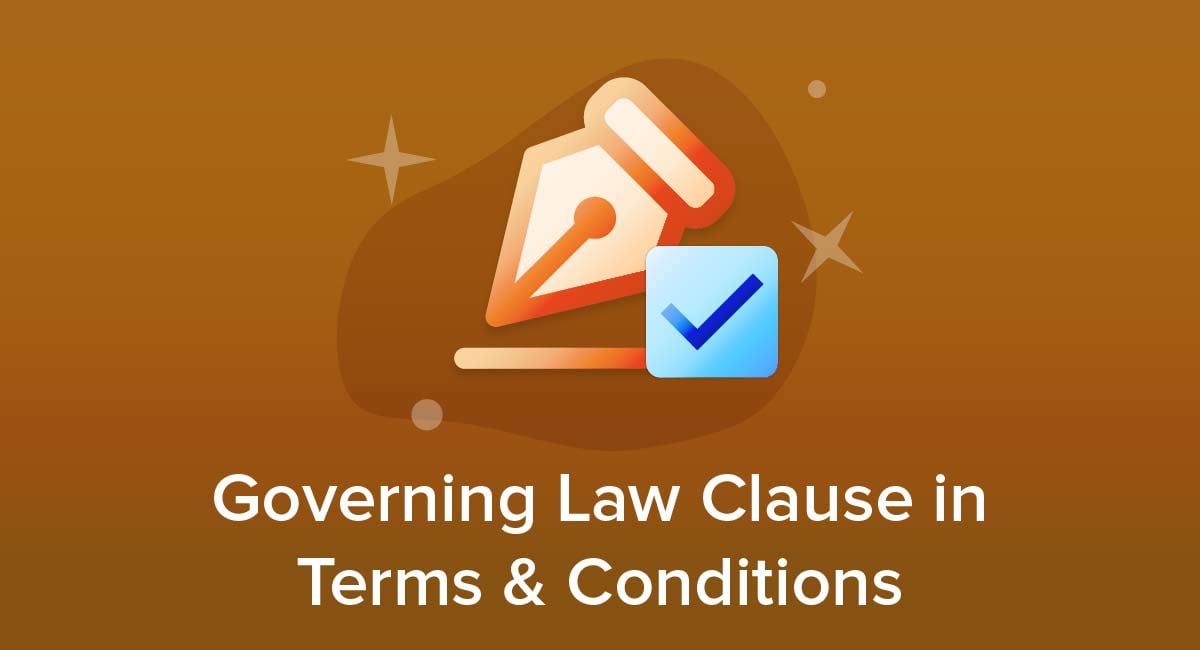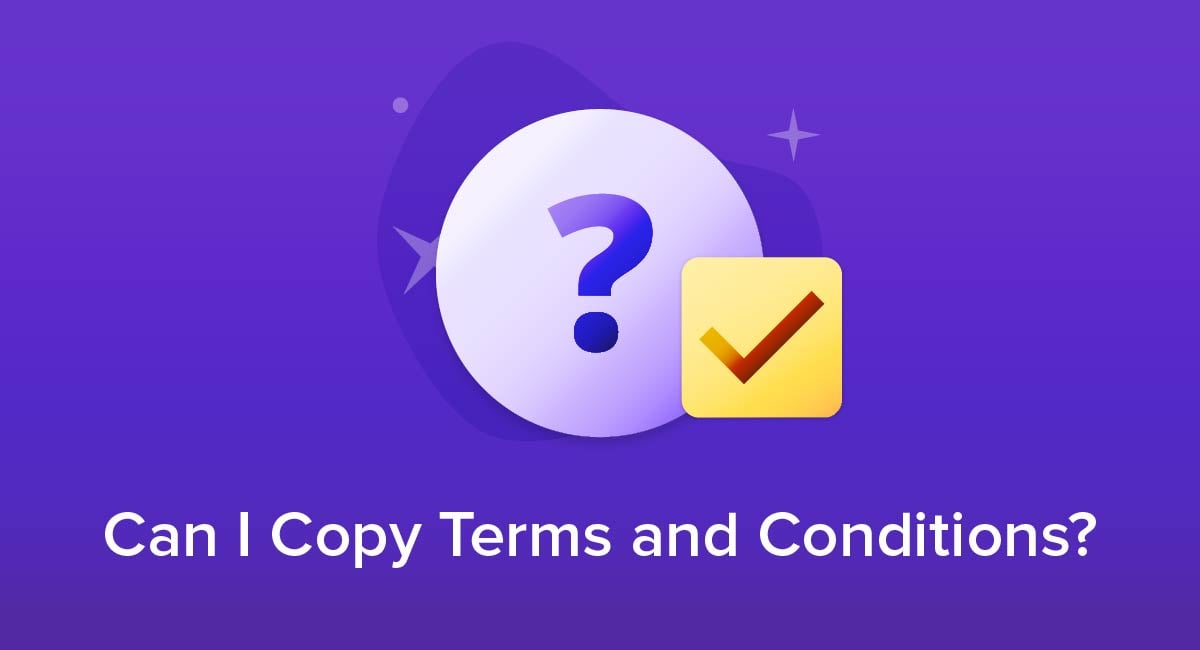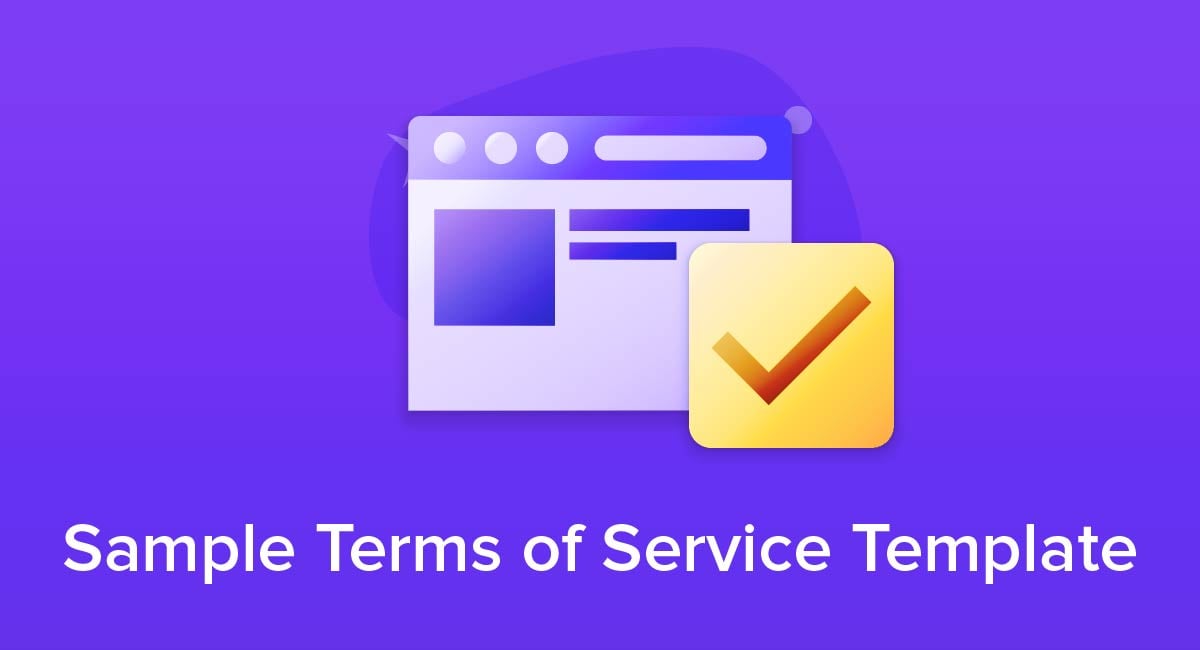
Whatever type of website you have, you'll usually need rules about how people use it. That's particularly the case if your users pay for a service or if you let users add content to your site or interact with other users.
Creating and displaying a Terms of Service agreement helps clarify your rules and helps give them legal force.
In this article we'll explain why this is the case, and we'll show you how to get started with creating your own.
Our Free Terms and Conditions Generator is created to help you generate a professionally drafted agreement that can include various terms and conditions for your site and/or app.
- Start the Free Terms and Conditions Generator from our website.
- Select platforms where your Terms and Conditions will be used (website, app or both):
- Answer a few questions about your website or app information:
- Select the country:
- Answer a few questions about your business practices:
-
Enter your email address where you'd like to receive the new Free Terms and Conditions and click "Generate":
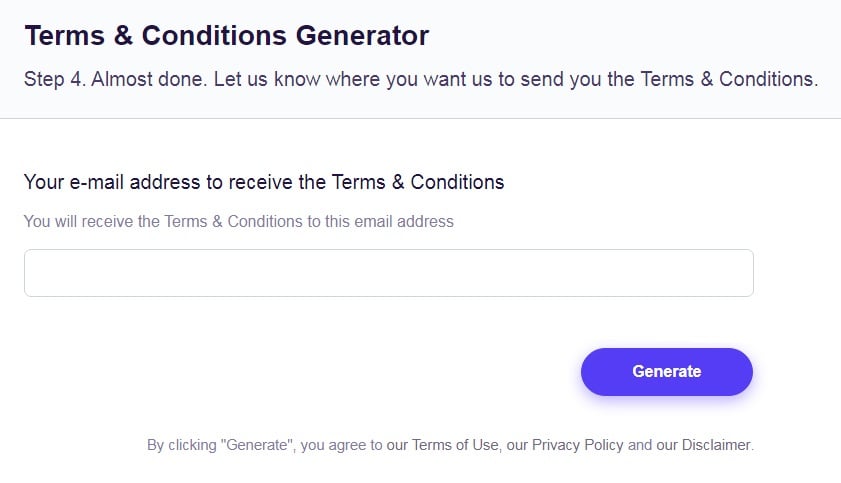
Once generated, you can copy and paste your Free Terms and Conditions agreement on your website or app or link to your hosted Free Terms and Conditions page.
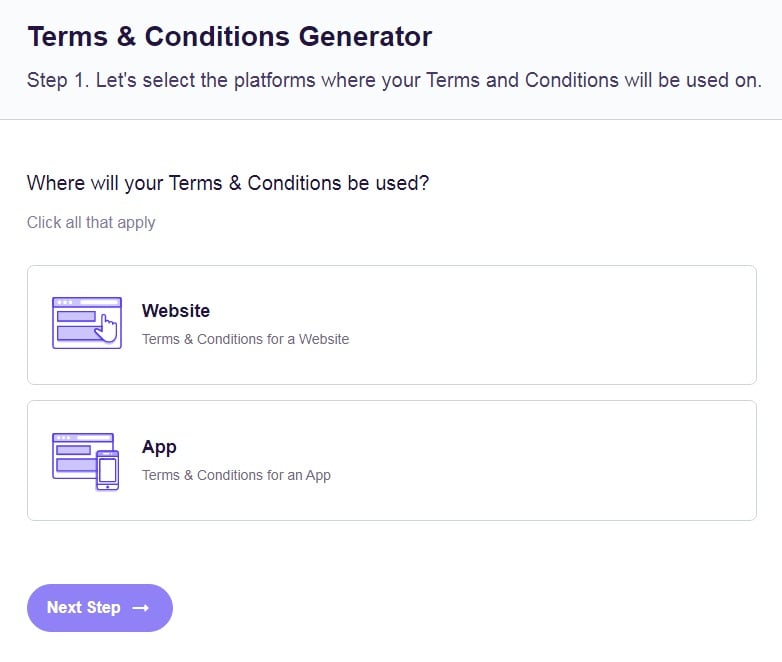
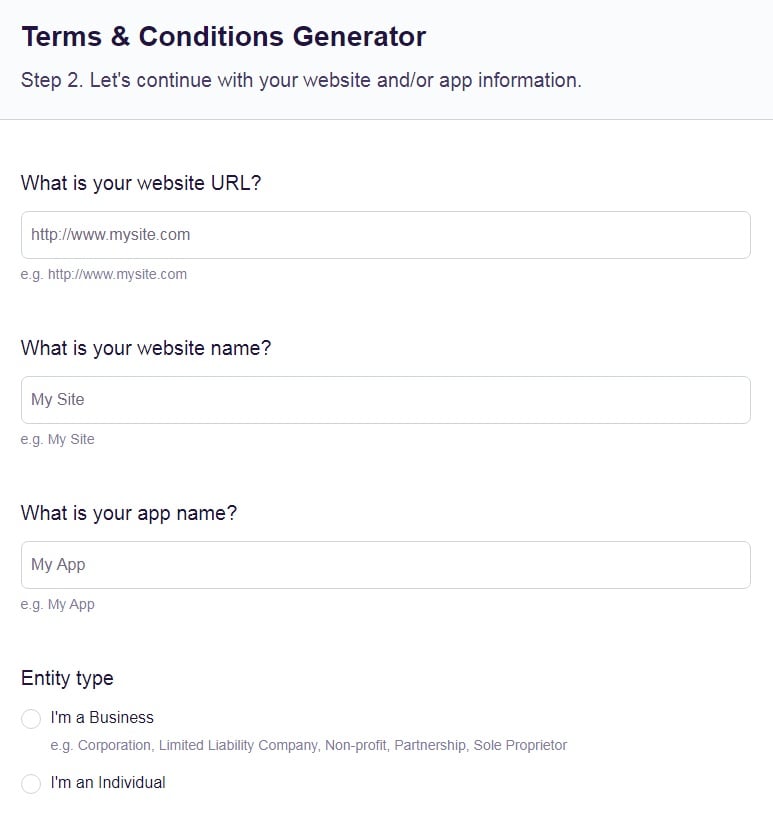
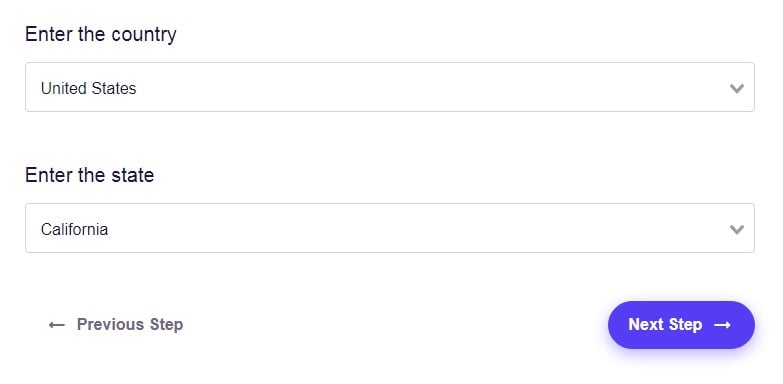
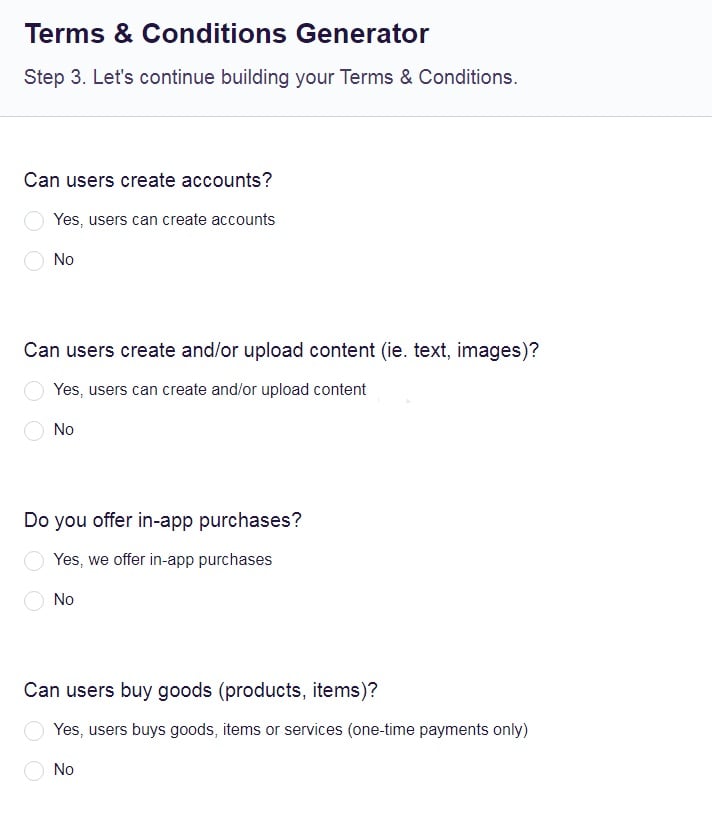
- 1. What's a Terms of Service Agreement?
- 2. Do I Need a Terms of Service Agreement By Law?
- 3. Why Should I Have a Terms of Service Agreement?
- 3.1. Protecting Your Business
- 3.2. Informing Users
- 3.3. Enforcing Rules
- 4. What Should Be In My Terms of Service Agreement?
- 4.1. Your Rules
- 4.2. Penalties
- 4.3. Intellectual Property Rights
- 4.4. Limitation of Liabilities
- 4.5. User-Generated Content
- 4.6. Contractual Terms
- 4.7. Legislative Context
- 5. Where to Put Your Terms of Service
- 6. How to Get Ensure Consent
- 7. Summary
What's a Terms of Service Agreement?
A Terms of Service agreement is a set of rules that covers how somebody can use a service (which can include a website). Normally the service provider will publish the Terms of Service and say the service user must agree to the terms as a condition of accessing the service.
The Terms of Service forms a legal agreement between the service provider and the service user. It can form part of a wider contract or act as a contract in itself.
Sometimes businesses use another expression such as Terms of Use or Terms & Conditions. There's no real distinction between the different terms. It's the content that has legal force rather than what you call it.
Do I Need a Terms of Service Agreement By Law?
There's generally no legal requirement to have a specific Terms of Service or similar document, particularly when you don't have a financial relationship with the service user (who may simply be a site visitor).
Note that sometimes your website may be legally required to include documents or text such as a Privacy Policy. You may also have to publish specific details for some types of online transaction such as with financial services or where you offer a warranty.
Why Should I Have a Terms of Service Agreement?

There are a number of important reasons why you should have this agreement even though not legally required to.
Protecting Your Business
The biggest reason for having Terms of Service is to protect your business. Setting out the Terms of Service lets you set the rules for the relationship between you and the service user. In turn, this reduces the risk of any ambiguity that might later lead to a ruling against you.
Informing Users
Having a clear, thorough Terms of Service helps prospective users make an informed decision about whether to use your services (including your website). This reduces the risk that they'll take legal action against you later on. It also helps them feel more confident that you are being straightforward with them, and are trustworthy and professional.
Enforcing Rules
Your Terms of Service can work in two ways to reduce harm caused by users, particularly if that could affect other customers.
Firstly, if people know the rules, they will be more likely to avoid taking harmful action in the first place. Secondly, it makes it much easier to enforce the rules - for example by banning people who abuse your website's functions - without fear of legal uncertainty.
What Should Be In My Terms of Service Agreement?

Exactly what should be in your Terms of Service will depend on factors including the jurisdiction covering you, your user base and the nature of your business.
We'll run through some of the most common clauses that you will want to include.
Your Rules
In simple terms, this clause will set out the conditions under which somebody can use your service. Most commonly it's a list of specific actions that they cannot take.
These clauses typically will include a ban on things like the following:
- Misusing the service for something other than its intended purpose
- Causing harm to your business or to other users
- Attempting to access data or services without permission
- Using the service in a way that breaks the law
This example from Facebook clearly lists the prohibited activities:
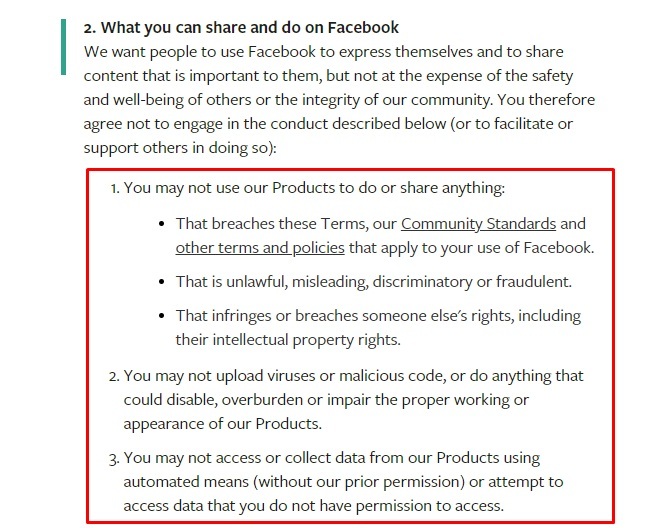
Penalties
This clause sets out the penalties if a user breaks the rules. The most common is to suspend or terminate the user's account (and by extension their access to the service). You should set out whether and how the user will get any warning before you take this action, for example if you operate a "strikes" policy.
It's particularly important to make clear whether you refund any service or subscription fees when you suspend or terminate an account.
You can also make clear that you reserve the right to pursue legal action for any material breaches of the Terms of Service.
This example from Google sets out both the measures and procedures for dealing with breaches by the user, including the right to appeal:
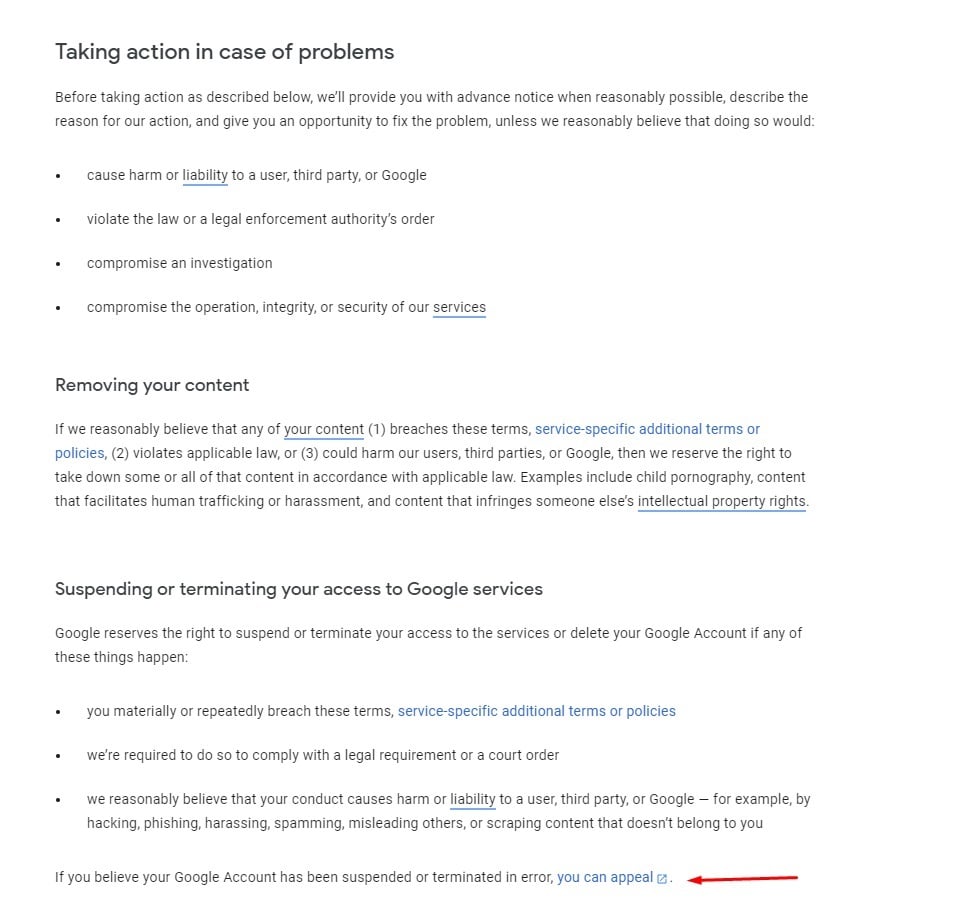
Intellectual Property Rights
This clause makes it clear that you own the intellectual property to all the content you publish on your site or make available through your service. This can cover:
- Copyrights
- Patents
- Trademarks
- Design Rights
You should also make clear that your granting access to the service doesn't give users any rights or licences to use, share or copy your intellectual property unless expressly stated.
This example from Apple covers the intellectual property rights as well as addressing what happens with downloaded material:
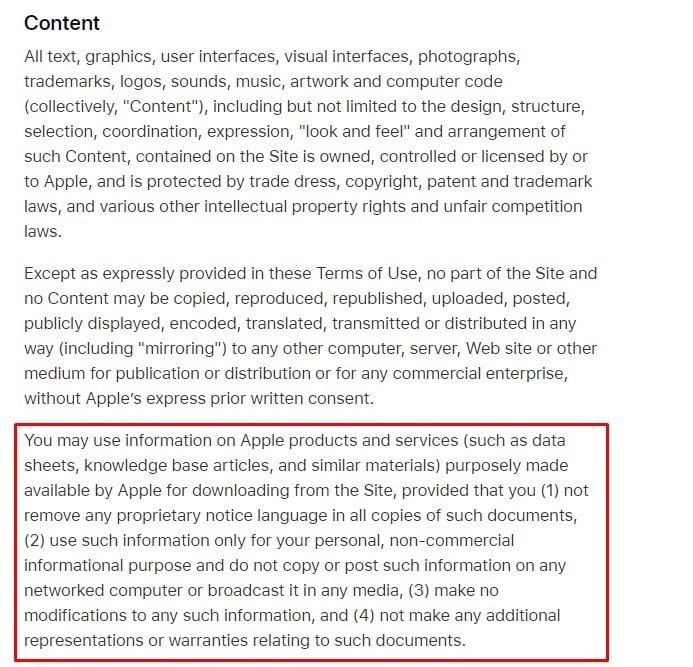
Limitation of Liabilities
This clause aims to limit your liability for any harm your actions or mistakes could cause. The most common example with websites is limiting liability for any errors in the content of your site.
Remember that even if a user agrees to your Terms of Service, the laws in your jurisdiction may restrict the ways you limit liability.
Some ways to increase the likelihood that a court will uphold your limitation of liability include the following:
- Write the clause as clearly as possible to make sure the user can understand how you are limiting liability.
- Be explicit about exactly what your limitation involves and what you do and don't accept liability for.
- Make sure the liability clause is prominent rather than try to hide it away.
- Consider whether the clause would feel reasonable to the average person.
This example from Disqus gives a clear example of a risk to the user and the fact that the service provider is disclaiming liability for this risk:
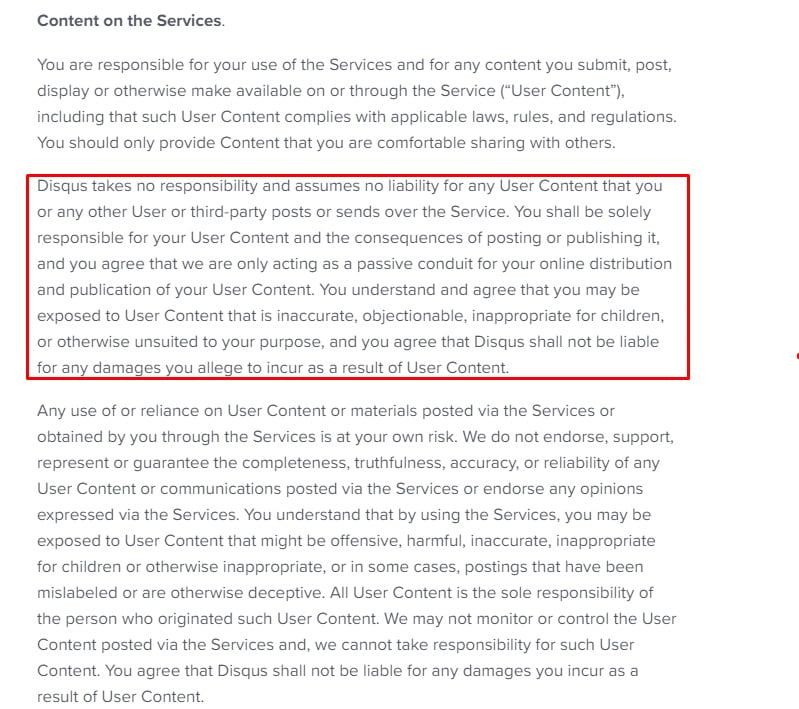
User-Generated Content
This clause covers any material that users can add to your site or service. Examples include posts on a message board, product reviews, social media content, photos and videos.
Some of the key points to address in this clause include:
- What responsibility you take for such content
- How you review and remove objectionable content
- Who holds the copyright to the content
This example from the New York Times covers several points including the copyright issue:
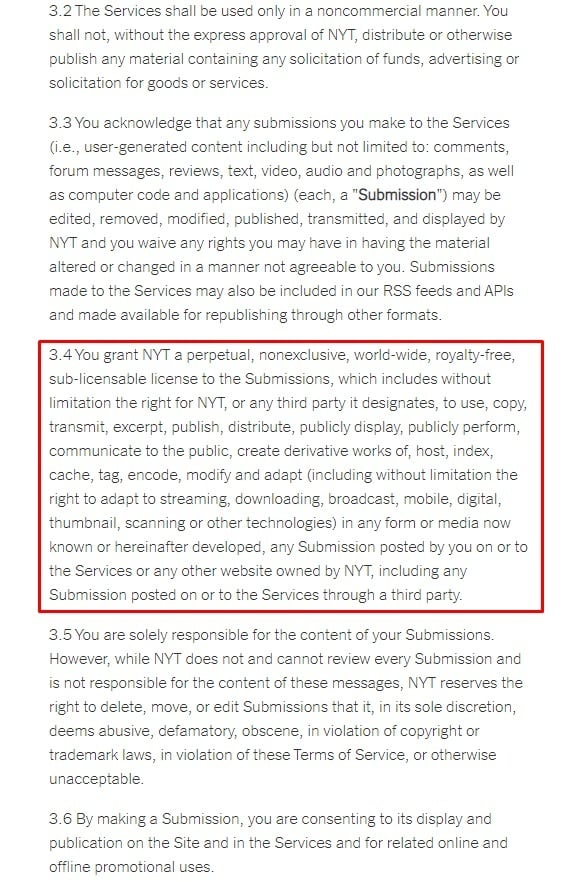
Contractual Terms
This clause is particularly appropriate when you offer a paid-for service. It sets out exactly what you offer in return for the payment. When writing this clause, consider issues such as:
- What happens if the user doesn't make the payment
- Whether you have the right to cancel the agreement by refunding the payment
- Whether any subscription or annual payments will automatically renew and what happens if you change the price
- What happens if the service is interrupted and you can't provide what a user paid for
This example from National Geographic covers these points along with a clear explanation that users who lose service by breaching the terms won't get a refund:
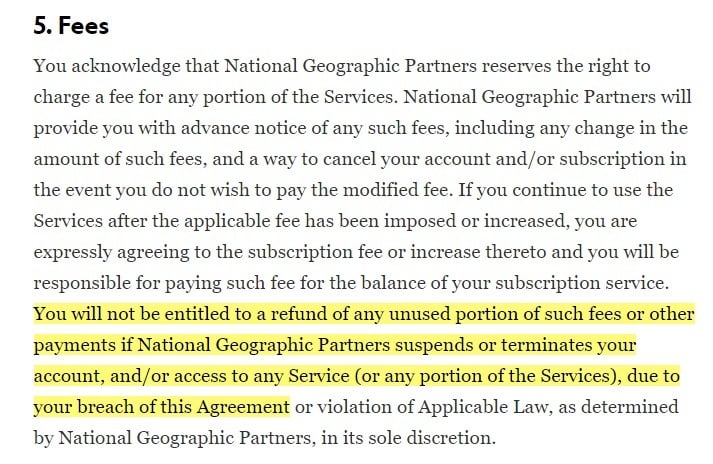
Legislative Context
This clause can cover two main points:
- Jurisdiction/Governing Law
- Dispute settlement
You should make clear which state or country's laws govern the Terms of Service. Most commonly this will be the jurisdiction where your business is legally registered or located.
Remember that this only applies to the Terms of Use itself. You may still be covered by other legal requirements such as data privacy regulations that depend on the location of the service user.
This example from ResearchGate is a little wordy but covers the relevant details. It makes sure to note that some laws may override the measures in this section:

You also may want to have the service user agree to a particular method of settling any legal dispute. This could mean taking any legal action in a particular court system or agreeing to go through third-party arbitration.
Here's an example of an arbitration clause from National Geographic that describes how both parties (National Geographic Partners and the users) will be agreeing not to sue if an issue arises and use arbitration instead:
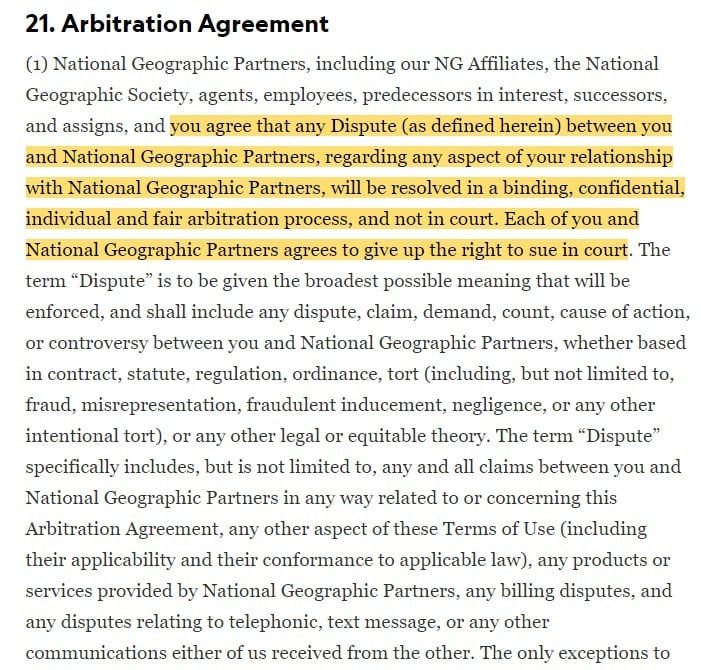
If you are in any way uncertain about your legal position, seek expert legal advice to make sure this clause is legally valid.
Where to Put Your Terms of Service

Even if you write clearly and concisely, your Terms of Service may (and likely will) end up being many paragraphs long. This means it's usually not practical to have it on your home page or on a page describing your service.
Instead the best option is usually to have a dedicated page for the Terms of Service.
At the minimum, you should link to the Terms of Service from your main navigation menu as in this example from the Washington Post:
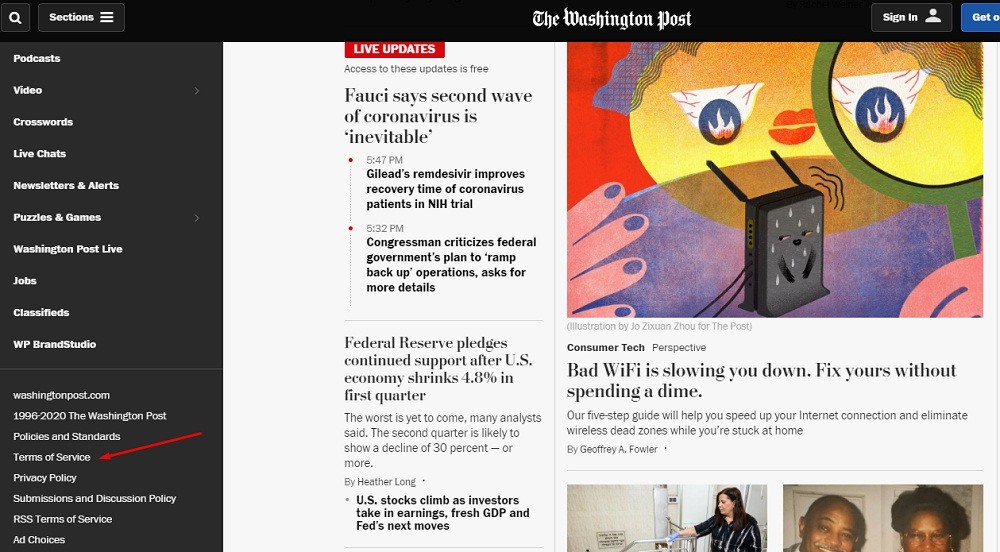
It's also a good idea and a common practice to include a clearly visible link in your website's footer as users know to look here, and it will be available on every page and section of your website.
The Washington Post links its Terms of Service here as well:

You should also include a prominent link at any point where users actively sign up for a service, provide user-generated content, or make a payment.
For example, Twitter includes agreement to the Terms as part of the sign-up confirmation:
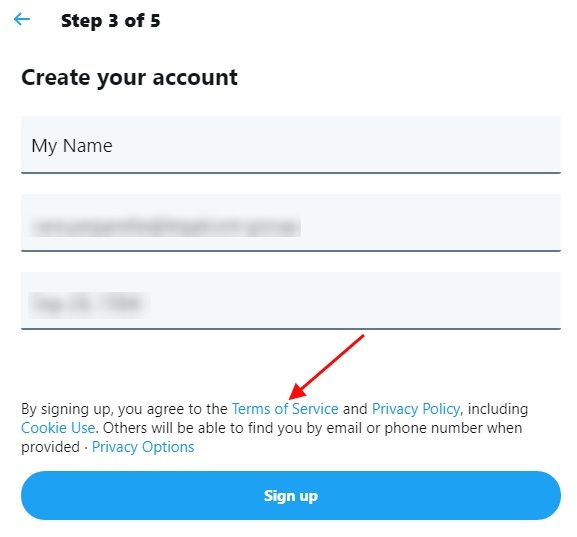
If your service is a mobile app, you can include a link in the app store description. Some app stores have a dedicated field for the link when you add the app.
As a Terms of Service agreement constitutes a contract, you should make sure it appears in a permanent form somewhere on your site so that a user can always return to later to review if desired.
How to Get Ensure Consent

Many businesses will simply post the Terms of Service somewhere on their website and leave it up to the user to decide whether to find and read it. Whether this is sufficient to have legal force will depend on the specific law and jurisdiction that covers any dispute.
If you are relying on the Terms of Service to protect you against legal challenges, it's safer to make sure the user actively confirms they have read and agree to your Terms of Service.
You can do this with a checkbox or button that the user must click before proceeding on your site.
It can be a balancing act between getting active consent in this way and not wanting to deter the user from accessing your site.
One option is to let users read your site without restriction, but require them to give consent at a key point such as when they are about to sign up to a service, post content or buy something.
Here's how Microsoft uses a clearly-labeled button and statement to get consent. Above the Next button is a statement that says, "Choosing Next means that you agree..."
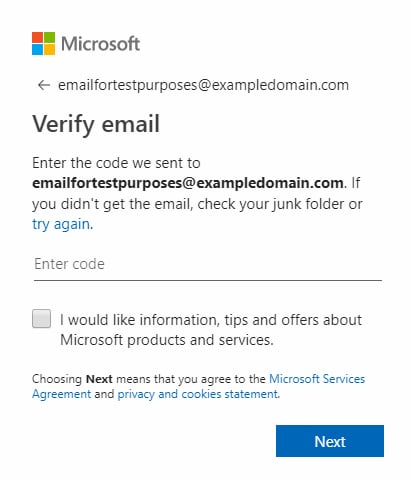
And here's how Birkenstock implements a checkbox that users can click to show they consent to the Terms:
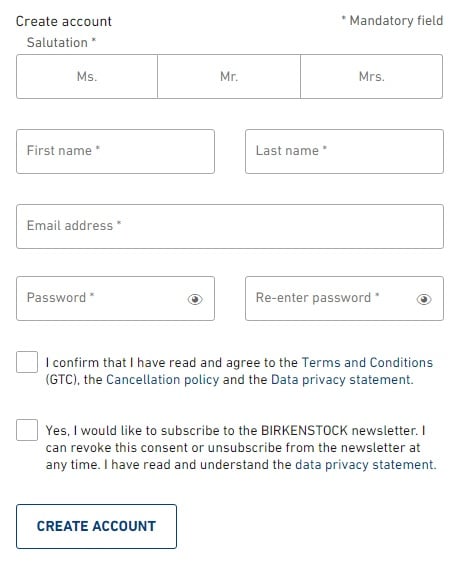
As a general rule, it's more important to get clear and active consent from the user if any of your Terms of Service are unusual or different to what people might assume was the case without reading them. However, you should always strive to get checkbox consent.
Summary
Let's recap what you need to know and do to make sure your Terms of Service agreement is valid and effective.
- Terms of Service agreements are a legal agreement between a company and its users. The user must agree to the terms as a condition of using the service.
- Terms of Service can also be called Terms and Conditions or Terms of Use.
-
You don't usually have to publish Terms of Service by law, but doing so has several benefits:
- Protection against legal claims
- Giving users clear information and building trust
- Making it easier to enforce your rules
-
Common clauses in a Terms of Service document include:
- Rules on how people can access and use the service including banned actions
- Penalties for users who breach the rules
- Intellectual property rights
- Liabilities (and limitations)
- User generated content
- Which jurisdiction governs the Terms of Service and how any dispute will be settled
- It's usually best to have Terms of Service on a dedicated page on your site. You should have clear and visible links to this page in your website footer and any point where the user is about to interact with your service.
- To ensure you have valid consent from the user, you can require them to click a button or a checkbox to confirm they've read and understand your Terms of Service.

